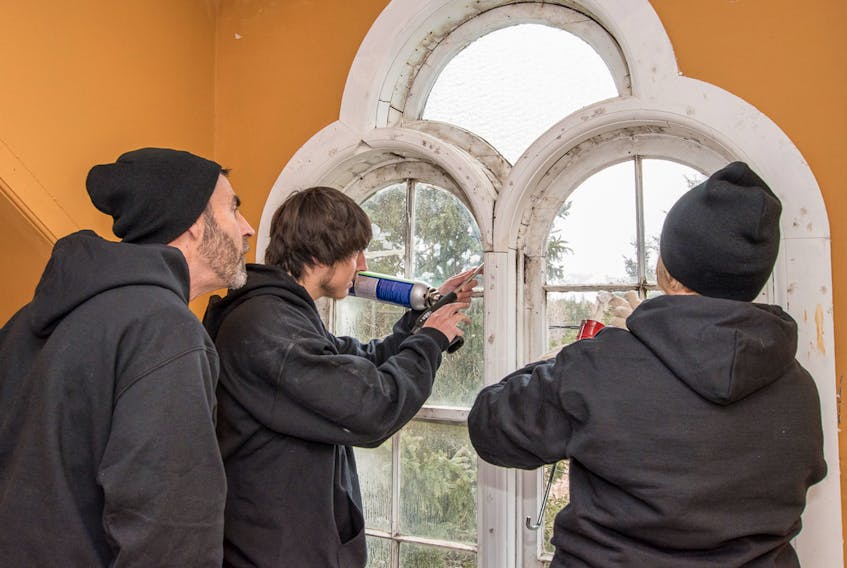TANTRAMAR, N.B. – Want to lessen your environmental impact and start living more sustainably?
Knowing where to begin can feel overwhelming, but the Sackville Tribune-Post has put together a list of easy and affordable ways residents in the Tantramar region can get started on today to reduce their environmental footprint.
1. Draft-proof your home
Do you have a drafty home, but are not sure where to turn to seal those air leaks and bring your energy use down? Your first step might be to get in touch with EOS Eco-Energy about having one of their draft-proofing work parties in your home.
All you have to do is to invite some friends over and EOS will bring all the air sealing materials, tools, and even party food – and it’s all free. EOS, a local organization dedicated to helping Tantramar residents find ways to live more sustainability, also covers the cost of a certified home energy advisor who brings a blower door unit that measures changes in air flow in the home. EOS staff and the energy advisor teach the homeowner where to look for drafts and how to seal them. Then, everyone gets down to work sealing air leaks during the three-hour party.
“Homeowners and party guests are always surprised to learn where drafts are coming from and really appreciate learning how to do the work themselves,” says Amanda Marlin, executive director of EOS.
Marlin says on average during a party, drafts are reduced by roughly 15 per cent but can sometimes be as high as 40 per cent.
“This translates into saving money on heating bills and also reducing emissions that contribute to climate change,” she says. “Homes are warmer and more comfortable too.”
The EOS draft-proofing work party program is open to all homeowners in the Tantramar region with priority for lower income residents, those in need, and those with non-electric heat sources. Marlin says since 2016, 45 tonnes of emissions have been saved annually thanks to the EOS program.
For more information on the program, contact Marlin at [email protected] or 536-4487.
There are also thousands of online resources that can provide you with the information you need on how to draft proof your home, from using weatherstripping to applying foam insulation to caulking your doors and windows.
Other ways to be an energy saver at home
• Install energy retrofits like LED light bulbs, shower heads and hot water pipe wrap.
• Add insulation.
• Turn the lights off when not in use.
• Conserve water by turning the tap off when you brush your teeth, take shorter showers.
• Build a rain barrel to help conserve water – use it to water gardens, clean your car.
2. Waste not, want not
Reduce, reuse and recycle. These three little words have been used for nearly a generation now to prompt people to take greater action to protect the earth – but they are three words that can’t be overstated enough.
From buying less packaged foods to using your own water bottle or travel mug to grabbing your reusable bags when heading out grocery shopping, there are so many ways residents can do their part to lessen their individual environmental footprint.
“There is a lot of single-use plastic and excessive packaging in our lives these days, and there are simple steps we can all take to reduce how much we use,” says Memramcook-Tantramar Green MLA Megan Mitton.
Mitton points out one simple way to do that is to create a habit of bringing your own shopping bags wherever you go.
“Most people already own reusable bags, the challenge is creating the habit of bringing them with us to stores (and not just the grocery store),” she says. “We need legislation to help eliminate the use of plastic bags; but in the meantime, we can choose not to use them.”

Marshview Middle School’s Engage Environment Group is also hoping to encourage residents to move away from single-use plastics such as drinking straws, water bottles, grocery bags, coffee cups, plastic cutlery and take-out containers.
This group of students, who recently made a presentation to town council with a number of recommendations, researched the use of single-use plastics locally and pointed out it’s the customers and the wider community who must demand a change to more environmentally-friendly alternatives. They encouraged the use of metal or glass straws, reusable water bottles and coffee mugs, and reusable cloth grocery bags.
Michael Fox, a geography and environment professor at Mount Allison University who is working with the environment group at Marshview, said reduce, reuse and recycle are still very important mantras residents can use in their daily lives.
“Buying products with minimal packaging will help to reduce waste,” he says. “And by recycling half of your household waste, you can save 2,400 pounds of carbon dioxide annually.”
Fox says it’s important for residents in the area to learn more about how the three-stream waste sorting system works in southeast New Brunswick so that more of their garbage can get recycled.
He says many area residents may not be aware that glass products put in their garbage goes into the landfill and is never recycled. But Sackville has a full-service bottle and can recycling centre right here in Sackville – Wheaton’s All-In-One at 13 Industrial Dr.
If you want to do even more to reduce your waste, you could join the Tantramar Zero Waste Living group on Facebook. This group is for local residents striving to reduce waste and plastics and maybe even live a zero waste life one day.
3. Walk more, drive less
Whether it’s biking, walking or carpooling, there are many ways local residents can reduce their emissions when travelling.
“Every gallon of gas you save not only helps your budget, it also keeps 20 pounds of carbon dioxide out of the atmosphere,” says Fox.
Fox says Sackville, in particular, is a very walkable community where you can easily cover a great distance within a 10-minute span.
If you do need to drive to get to where you’re going, try and buy the smallest vehicle for your needs with the best fuel efficiency, suggests EOS in its online tips for living sustainably.
Fox recommends also making sure your car is running efficiently. Keeping your tires properly inflated, for example, can improve your gas mileage by more than three per cent.
Area residents can also consider carpooling or joining/starting a ride-share program.
4. Plant a rain garden
Planting a rain garden in your yard is a great way to help reduce localized flooding, reduce runoff and erosion, says Marlin.
Designed to collect rain water from roofs, parking lots, driveways or other surfaces, including lawns, rain gardens are planted with native flowers, grasses, plants and shrubs and allow rain to be absorbed naturally into the ground. The deep roots of the plants also help to break up the soil and increase its permeability, explains Marlin. She says the rain gardens are also great pollinator gardens.

“They are a low-cost and beautiful way to help address flooding during a good portion of the year,” she says.
EOS has funding from Environment Canada’s Eco-Action Community Funding program to plant up to 20 rain gardens on residential properties in downtown, flood-prone Sackville over the next two years.
Although the program is full for this coming summer, spaces remain for summer 2020. You can also find out more about planting your own rain garden at eosecoenergy.com.
5. Change the way you eat
We all need to eat multiple times a day, and this presents many opportunities for us to choose more environmentally-friendly foods for our diet, says Mitton.
There are a number of ways to reduce the impact of your diet, she says. For instance, residents can try ‘ Meatless Mondays,’ where they can opt to eat plant-based meals once a week.
“Studies show dietary changes, such as doing Meatless Mondays, can reduce our impact on the environment and the United Nations has encouraged everyone to eat lower on the food chain for environmental reasons,” Mitton explains.
While some people are vegetarian, others choose to be “flexitarian,” she says, which means they simply choose to eat fewer animal products but don’t cut them out completely.
“There are countless websites and cookbooks that provide new recipes and an opportunity to try new foods. But there are also simple options, like peanut butter and jelly sandwiches or pasta and tomato sauce, that are easy to make if you don’t know where to start.”
She also suggested buying local food whenever possible, buying organic when possible, growing your own food (even if you just grow some herbs and spices to start), and reducing food waste, which means better meal planning, eating leftovers, and not buying too much at once.
6. Learn more, share with others
Fox says when it comes to one’s responsibility for our impact on the environment: “Think globally, act locally.”
Tantramar, with more than 500 educators and 3,000 students living and working here, is the ideal community to take on this approach to the environment, he says.
“I truly believe that ‘all education is environmental education,’ so our community is well placed to act individually and collectively in reducing our impacts here in our own place, but also learning of the global significance of our actions.”

He says that by acting locally and reducing our impacts on the earth, parents, teachers, the media, and students can share information about recycling and energy conservation with their friends, neighbours and co-workers, and take opportunities to encourage public officials to establish programs and policies that are good for the environment.
“Working locally, we recognize that we are addressing global climate change, the most pressing environmental issue of our time, while learning to live well in our place.”
7. Get involved
There are many ways to get involved, both locally and on a wider scale, when it comes to environmental issues – it all depends on how you’d like to contribute and the time you can spend doing so.
You can run for election or you can help on a campaign.
You can write letters and contact your government representatives or businesses to explain the changes you want to see and offer suggestions for how they could make it happen.
“We need government leadership and action, which often requires citizens and communities to take action by telling politicians they want change,” says Mitton.
You can raise awareness by starting a petition or hosting (or joining) a march. Or you can start an education campaign and write articles for your local paper.
Joining an environmental organization is also a great way to get involved.
Mitton says more collective action is also needed if there is to be real change effected.
“When we put all the responsibility for change on individuals and their actions, we miss the opportunity for systemic change, which is necessary for us to reduce our negative impacts on the environment.
“We can’t make these bigger changes on our own,” she says. “We need to work together. One action you can take is supporting local environmental groups that are already working on solutions for these issues.”
“While I think writing letters, signing petitions, and meeting with your politicians is important, it can be more effective if you work with others to take action together. You don’t need to work on these things alone and, in fact, working as a community will help change happen faster.
Mitton says it’s important as well for individuals to not get too overwhelmed by making these changes.
“If you make a mistake, don’t get discouraged - you can do better next time. If we focus all our energy worrying about the tiny things, we risk not making the bigger changes that will have a more significant impact.”
For more information, check out EOS Eco-Energy’s tips on living sustainably.
RELATED:









